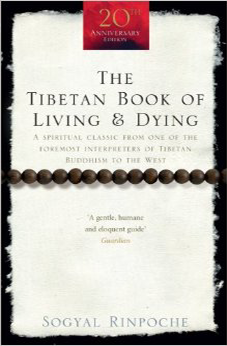The Tibetan Book Of Living And Dying by Sogyal Rinpoche

Written by the Buddhist meditation master and popular international speaker Soygal Rinpoche, this highly acclaimed book clarifies the majestic vision of life and death that underlies the Tibetan Buddhist tradition. It includes not only a lucid, inspiring and complete introduction to the practice of meditation but also advice on how to care for the dying with love and compassion, and how to bring them help of a spiritual kind. But there is much more besides in this classic work, which was written to inspire all who read it to begin the journey to enlightenment and so become ‘servants of peace.’
Editorial Reviews
Amazon.com Review
In 1927, Walter Evans-Wentz published his translation of an obscure Tibetan Nyingma text and called it the Tibetan Book of the Dead. Popular Tibetan teacher Sogyal Rinpoche has transformed that ancient text, conveying a perennial philosophy that is at once religious, scientific, and practical. Through extraordinary anecdotes and stories from religious traditions East and West, Rinpoche introduces the reader to the fundamentals of Tibetan Buddhism, moving gradually to the topics of death and dying. Death turns out to be less of a crisis and more of an opportunity. Concepts such as reincarnation, karma, and bardo and practices such as meditation, tonglen, and phowa teach us how to face death constructively. As a result, life becomes much richer. Like Elisabeth Kubler-Ross, Sogyal Rinpoche opens the door to a full experience of death. It is up to the reader to walk through. –Brian Bruya
From Library Journal
Copyright 1999 Reed Business Information, Inc.
Review
“Sogyal Rinpoche…has delivered the Tibetanequivalent of ‘The Divine Comedy.’ One could imaginethat this is what Dante might have written had he beena Buddhist metaphysician rather than a Christian poet.” –“New York Times Book Review”Rinpoche’s teachings have much to offer…. His down-to-earth tone, peppered with songs and poetry from Buddhist sages, takes away much of the intense fear of death and makes it seem like an old friend.”–“Los Angeles Times”A magnificent achievement. In its power to touch the heart, to awaken consciousness, it is an inestimable gift.”–“San Francisco Chronicle Book Review
From the Back Cover
“What is it I hope for from this book? To inspire a quiet revolution in the whole way we look at health and care for the dying, and the whole way we look at life and care for the living.”
This acclaimed spiritual masterpiece is widely regarded as one of the most complete and authoritative presen-tations of the Tibetan Buddhist teachings ever written. A manual for life and death and a magnificent source of sacred inspiration from the heart of the Tibetan tradition, The Tibetan Book of Living and Dying provides a lucid and inspiring intro-duction to the practice of meditation, to the nature of mind, to karma and rebirth, to compassionate love and care for the dying, and to the trials and rewards of the spiritual path.
Buddhist meditation master and international teacher Sogyal Rinpoche brings together the ancient wisdom of Tibet with modern research on death and dying and the nature of the universe. With unprecedented scope, The Tibetan Book of Living and Dying clarifies the majestic vision of life and death that underlies the classic sacred text The Tibetan Book of the Dead. Sogyal Rinpoche presents simple yet powerful practices from the heart of the Tibetan tradition that anyone, whatever their religion or background, can do to transform their lives, prepare for death, and help the dying.
About the Author
Sogyal Rinpoche was born in Tibet and raised by one of the most revered spiritual masters of this century, Jamyang Khyentse Chökyi Lodrö. With the Chinese occu-pation of Tibet, he went into exile with his master, who died in 1959 in Sikkim in the Himalayas. After university studies in Delhi and Cambridge, England, he acted as translator and aide to several leading Tibetan masters, and began teaching in the West in 1974. Rinpoche sees his life’s task as transplanting the wisdom of the Buddha to the West by offering training in the vision set out in The Tibetan Book of Living and Dying. This training can enable those who follow it to understand, embody, and integrate Buddhist teachings into their everyday lives.
Rinpoche’s reputation as an authority on the teachings associated with The Tibetan Book of Living and Dying and his dialogue with leading figures in the fields of psychology, science, and healing make him a sought-after speaker at international conferences and lectures. He travels extensively, teaching in North America, Europe, Australia, and Asia, and is the founder and spiritual director of Rigpa, a network of Buddhist centers and groups around the world.


Leave a Comment
You must be logged in to post a comment.